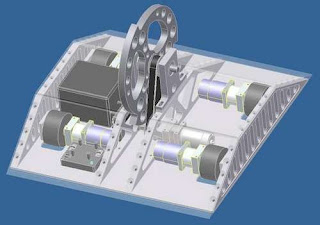Combat robots have been entertaining and amusing since before they were popular on Comedy Central.
A while back I undertook the challenge of building a couple of combat robots (a 30lb and a 220lb). Regardless of the size of the machine the steps in the process are the same. This Instructable will walk you through the steps and provide you with resources to help with the machine and give an understanding of what is involved using my 30lb robot as an example.
Step 1Decide what size robot you want to build
Combat robots come in many sizes from 75grams to 340lbs each one of them has their pros and cons. The first thing to do when thinking about building is to find the competition which you want to compete and see what weight classes are going to be there, because what is the point of building a bot you can never fight. Listing of robotic competitions are available on http://www.buildersdb.com andhttp://www.robotevents.com.
Large robots: 60lbs +
There is nothing like the thrill of seeing two large machines hitting each other with the force of a small car wreck. When most people think of combat robots it is these larger machines which first cross your mind. If you are fortunate to live near one of the large robotic events these machines can be fun builds, but at the same time the level of engineering required can be quite difficult. These large machines can also cost quite a bit of money. When you commit to building a machine this size you are committing at least $1000, and in many cases much more. I would estimate that your average heavy weight (220lbs) would cost a builder $4000-$5000 to build a competitive machine, and it is not uncommon to see builders spend upwards of $15,000+ on their machines over the course of a few years. In the days when combat robotics was televised there were many sponsorship opportunities which would subsidize the cost, unfortunately now as a builder you will be on your own.
On the good side of larger machines is that many times you can find surplus parts online which can reduce the cost of the machine. Using off the shelf components such as items fromhttp://www.teamwhyachi.com/ or http://www.AndyMark.biz can help make things easier. There are more of these components available for larger machines. Those Larger machines also have the added ability for service, fixing a machine is much easier the larger it is. Building a large robot can be both fun and enjoyable and you wont regret being able to say "I have a 120 lb battlebot in my garage"
Small Robot:
Building a small robot can be alot of fun but also a good challenge, with a restricted weight limit it makes every part on the machine to be critically thought about and designed. Most people are drawn to these smaller machines because of the frequency of competitions for them as well as the ability to transport them easily. While it is the common misconception that small robots are cheap they can be just as expensive as their larger counterparts. Alot of times the small electronics required for these can cost quite a bit as compared to larger components.
weight classes (list from wikipedia):
- 75g- Fleaweight
- 150g- Fairyweight (UK - Antweight)
- 1 pound (454 g) - Antweight
- 1 kilogram (2.2 lbs) Kilobot
- 3 pound (1.36 kg) - Beetleweight
- 6 pound (2.72 kg) - Mantisweight
- 12 pound (5.44 kg) - Hobbyweight
- 15 pound (6.80 kg) - BotsIQ Mini class
- 30 pound (14 kg) - Featherweight
- 60 pound (27 kg) - Lightweight
- 120 pound (54 kg) - Middleweight
- 220 pound (100 kg) - Heavyweight
- 340 pound (154 kg) Super Heavyweigh
t










0 Comments